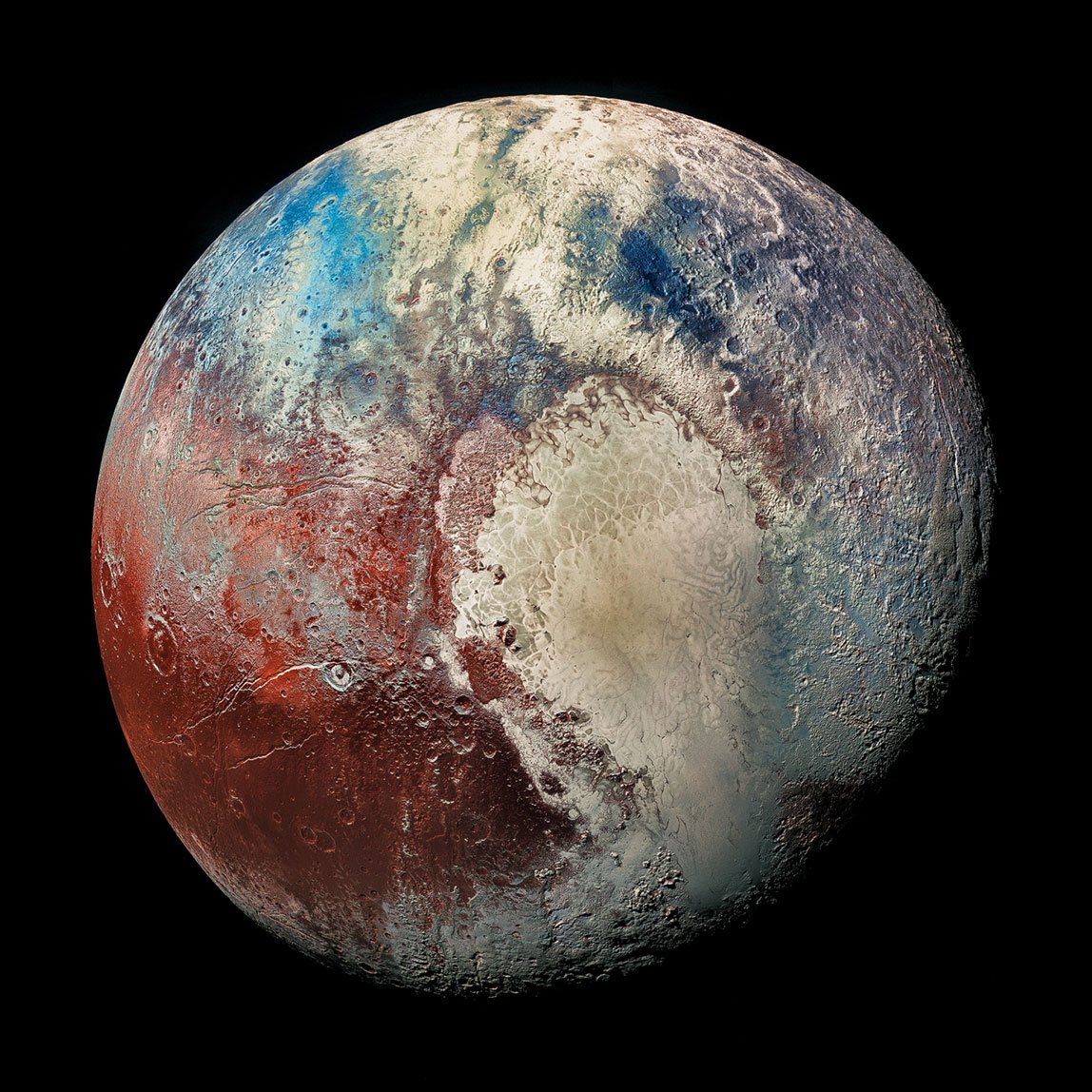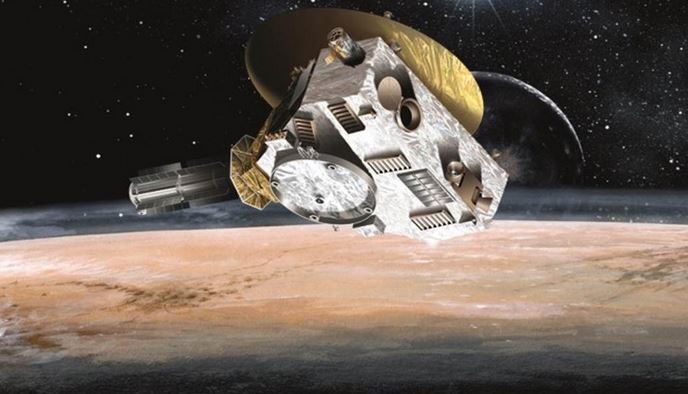- Sat Jan 18, 2014 10:33 am
#7729
"The Unexplored Planet" - NASA's Fastest Spaceship on Approach to Pluto
The Daily Galaxy: January 15, 2014
One of the fastest spacecraft ever built -- NASA's New Horizons -- is hurtling through the void at nearly one million miles per day. Launched in 2006, it has been in flight longer than some missions last, and it is nearing its destination: Pluto.

“There is a real possibility that New Horizons will discover new moons and rings as well,” says Alan Stern, of the Southwest Research Institute and the mission’s principal investigator. Already, Pluto has five known moons: Charon, Styx, Nix, Kerberos, and Hydra. Numerical simulations show that meteoroids striking those satellites could send debris into orbit, forming a ring system that waxes and wanes over time in response to changes in bombardment. “We’re flying into the unknown,” says Stern, “and there is no telling what we might find. The encounter begins next January,” adds Stern. “We’re less than a year away.”
Other than a few indistinct markings seen from afar by Hubble, Pluto’s landscape is totally unexplored. Although some astronomers call Pluto a “dwarf” planet, Stern says there’s nothing small about it. “If you drove a car around the equator of Pluto, the odometer would rack up almost 5,000 miles—as far as from Manhattan to Moscow.” Such a traveler might encounter icy geysers, craters, clouds, mountain ranges, rilles and valleys, alongside alien landforms no one has ever imagined.
Closest approach is scheduled for July 2015 when New Horizons flies only 10,000 km from Pluto, but the spacecraft will be busy long before that date. The first step, in January 2015, is an intensive campaign of photography by the Long Range Reconnaissance Imager or “LORRI.” This will help mission controllers pinpoint Pluto's location, which is uncertain by a few thousand kilometers.
"LORRI will photograph the planet against known background star fields," explains Stern. "We’ll use the images to refine Pluto’s distance from the spacecraft, and then fire the engines to make any necessary corrections.”
At first, Pluto and its large moon Charon will be little more than distant pinpricks—“a couple of fat pixels,” says Stern--but soon they will swell into full-fledged worlds.

New Horizons Reveals Dunes Made of Tiny Grains of Solid
By late April 2015, the approaching spacecraft will be taking pictures of Pluto that surpass the best images from Hubble. By closest approach in July 2015, a whole new world will open up to the spacecraft’s cameras. If New Horizons flew over Earth at the same altitude, it could see individual buildings and their shapes. The image above NASA space-artist Ron Miller's concept of geysers and sundogs on Pluto.
“Humankind hasn't had an experience like this--an encounter with a new planet--in a long time,” he says. “Everything we see on Pluto will be a revelation.”
He likens New Horizons to Mariner 4, which flew past Mars in July 1965. At the time, many people on Earth, even some scientists, thought the Red Planet was a relatively gentle world, with water and vegetation friendly to life. Instead, Mariner 4 revealed a desiccated wasteland of haunting beauty. New Horizons’ flyby of Pluto will occur almost exactly 50 years after Mariner 4’s flyby of Mars—and it could shock observers just as much.
Although temperatures on Pluto's surface hover around -230 °C, but researchers have long wondered whether the dwarf planet might boast enough internal heat to sustain a liquid ocean under its icy exterior.
Guillaume Robuchon and Francis Nimmo at the University of California, Santa Cruz, have calculated that the presence of an ocean depends on two things: the amount of radioactive potassium in Pluto's rocky core, and the temperature of the ice that covers it.

Density measurements suggest a rocky core fills 40 per cent of the dwarf planet's volume. If the core contains potassium at a concentration of 75 parts per billion, its decay could produce enough heat to melt some of the overlying ice, which is made of a mixture of nitrogen and water.
It should have at least that much potassium and probably more, says William McKinnon at Washington University in St Louis, Missouri, who points out that Earth, which probably formed with less of the volatile element due to its closer distance to the sun, has 10 times that concentration in its core.
Heat from Pluto's core will trigger convection in the surrounding ice, and if the ice churns too quickly, the heat will simply escape into space before it can do much melting. If it flows substantially more slowly than Antarctic glaciers on Earth, however, then the top 165 kilometres of ice could provide enough insulation for a liquid ocean of the same depth to exist below, the team concluded.
The viscosity of the ice depends on the size of individual ice particles, with smaller grains flowing more easily. There is no way to measure this from Earth, but Pluto's shape could reveal evidence of an ocean, the team says. Pluto's spin is slowing down due to tugs from its large moon Charon. Fast-spinning objects bulge out at their equator, but a soft interior would allow the world to relax into more of a sphere as its spin slows down. NASA's New Horizons probe will image the dwarf planet's shape when it flies past in 2015.
"It's very exciting to think that these dwarf planets could have astrobiological potential," says Stern.
Source: The Daily Galaxy
The Daily Galaxy: January 15, 2014
One of the fastest spacecraft ever built -- NASA's New Horizons -- is hurtling through the void at nearly one million miles per day. Launched in 2006, it has been in flight longer than some missions last, and it is nearing its destination: Pluto.

“There is a real possibility that New Horizons will discover new moons and rings as well,” says Alan Stern, of the Southwest Research Institute and the mission’s principal investigator. Already, Pluto has five known moons: Charon, Styx, Nix, Kerberos, and Hydra. Numerical simulations show that meteoroids striking those satellites could send debris into orbit, forming a ring system that waxes and wanes over time in response to changes in bombardment. “We’re flying into the unknown,” says Stern, “and there is no telling what we might find. The encounter begins next January,” adds Stern. “We’re less than a year away.”
Other than a few indistinct markings seen from afar by Hubble, Pluto’s landscape is totally unexplored. Although some astronomers call Pluto a “dwarf” planet, Stern says there’s nothing small about it. “If you drove a car around the equator of Pluto, the odometer would rack up almost 5,000 miles—as far as from Manhattan to Moscow.” Such a traveler might encounter icy geysers, craters, clouds, mountain ranges, rilles and valleys, alongside alien landforms no one has ever imagined.
Closest approach is scheduled for July 2015 when New Horizons flies only 10,000 km from Pluto, but the spacecraft will be busy long before that date. The first step, in January 2015, is an intensive campaign of photography by the Long Range Reconnaissance Imager or “LORRI.” This will help mission controllers pinpoint Pluto's location, which is uncertain by a few thousand kilometers.
"LORRI will photograph the planet against known background star fields," explains Stern. "We’ll use the images to refine Pluto’s distance from the spacecraft, and then fire the engines to make any necessary corrections.”
At first, Pluto and its large moon Charon will be little more than distant pinpricks—“a couple of fat pixels,” says Stern--but soon they will swell into full-fledged worlds.

New Horizons Reveals Dunes Made of Tiny Grains of Solid
By late April 2015, the approaching spacecraft will be taking pictures of Pluto that surpass the best images from Hubble. By closest approach in July 2015, a whole new world will open up to the spacecraft’s cameras. If New Horizons flew over Earth at the same altitude, it could see individual buildings and their shapes. The image above NASA space-artist Ron Miller's concept of geysers and sundogs on Pluto.
“Humankind hasn't had an experience like this--an encounter with a new planet--in a long time,” he says. “Everything we see on Pluto will be a revelation.”
He likens New Horizons to Mariner 4, which flew past Mars in July 1965. At the time, many people on Earth, even some scientists, thought the Red Planet was a relatively gentle world, with water and vegetation friendly to life. Instead, Mariner 4 revealed a desiccated wasteland of haunting beauty. New Horizons’ flyby of Pluto will occur almost exactly 50 years after Mariner 4’s flyby of Mars—and it could shock observers just as much.
Although temperatures on Pluto's surface hover around -230 °C, but researchers have long wondered whether the dwarf planet might boast enough internal heat to sustain a liquid ocean under its icy exterior.
Guillaume Robuchon and Francis Nimmo at the University of California, Santa Cruz, have calculated that the presence of an ocean depends on two things: the amount of radioactive potassium in Pluto's rocky core, and the temperature of the ice that covers it.

Density measurements suggest a rocky core fills 40 per cent of the dwarf planet's volume. If the core contains potassium at a concentration of 75 parts per billion, its decay could produce enough heat to melt some of the overlying ice, which is made of a mixture of nitrogen and water.
It should have at least that much potassium and probably more, says William McKinnon at Washington University in St Louis, Missouri, who points out that Earth, which probably formed with less of the volatile element due to its closer distance to the sun, has 10 times that concentration in its core.
Heat from Pluto's core will trigger convection in the surrounding ice, and if the ice churns too quickly, the heat will simply escape into space before it can do much melting. If it flows substantially more slowly than Antarctic glaciers on Earth, however, then the top 165 kilometres of ice could provide enough insulation for a liquid ocean of the same depth to exist below, the team concluded.
The viscosity of the ice depends on the size of individual ice particles, with smaller grains flowing more easily. There is no way to measure this from Earth, but Pluto's shape could reveal evidence of an ocean, the team says. Pluto's spin is slowing down due to tugs from its large moon Charon. Fast-spinning objects bulge out at their equator, but a soft interior would allow the world to relax into more of a sphere as its spin slows down. NASA's New Horizons probe will image the dwarf planet's shape when it flies past in 2015.
"It's very exciting to think that these dwarf planets could have astrobiological potential," says Stern.
Source: The Daily Galaxy
"You never change things by fighting the existing reality. To change something, build a new model that makes the existing model obsolete." R.Buckminster Fuller

